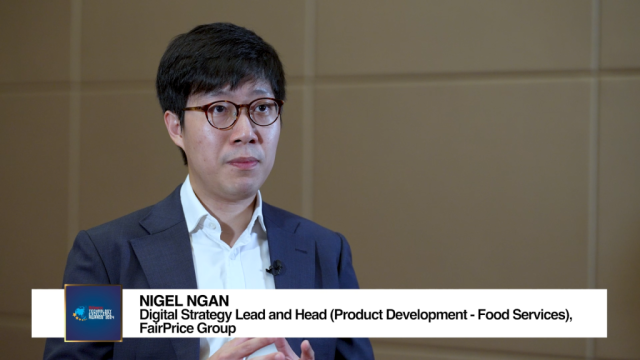
Should Singapore rethink tightened foreign labour inflow policy amid inflation spikes?
Technical recession is looming and experts are wary over stagflation.
In a recent report by DBS, it pointed out that Singapore’s inflation has always been lower than the Asia-8 until mid 2010. And Singapore’s inflation in recent years has predominantly been driven by domestic factors, it said.
DBS argued that high inflation in Singapore has affected overall competitiveness of Singapore versus Asian peers in recent years. This, it said is evident in the narrowing gap between Real Effective Exchange Rate (REER) and Nominal Effective Exchange Rate (NEER) in the last two years as well as faster appreciation of the Singapore’s REER versus the average REER for Asia-8 countries.
As at August 2012, Singapore's inflation stood at 3.90%, which is well above Asia's 2.1% on the average.
Check out this graph:

High COE premiums and rentals, as well as the continued increase in labour cost are the key drivers. DBS however said that ironically, the bulk of these were policy-induced.
"The tightening in foreign labour inflow in particular, is creating significant strain on enterprises and eroding Singapore’s cost competitiveness. The near- term impact is higher labour costs, compression of profit margins and the tendency for companies to pass on this higher cost to consumers, resulting in higher inflation. Thus, in a bid to restructure the economy, growth and competitiveness have been affected, and just when the global cycle is weak," it added.
As such, DBS said that Singapore's nipping foreign labour inflow policy may warrant a review.
Singapore Business Review interviewed several other economists to get their views on this issue and here's what they had to say:
Francis Tan, Economist, United Overseas Bank
Using abundant low wage foreign labour has helped kept Singapore cost competitive and inflation low for most of the last decade or so. However, it has come at the cost of low productivity and inadvertently, it also put strain on both the physical infrastructure and the social fabric of Singapore. Thus, the process of lowering Singapore’s structural reliance on low-cost labour should not be stopped although in the times of weaker growth, the pace of turning off the tap (for foreign worker inflows) should be adjusted to allow businesses and consumers more breathing space to adapt to higher labour costs.
Moreover, labour cost is not the only factor we should focus on in managing Singapore’s cost competitiveness against the backdrop of rising inflation and weaker growth outlook. One indicator of cost competitiveness is the Singapore Unit Business Costs. Deviation between Unit Labour costs (ULCs) and Unit Business costs (UBCs) of manufacturing since 2009 suggests that the increase in UBCs was not due to a tighter labour market, but higher industrial property prices seen in recent years. Over in the services sectors, although several clusters such as hotels & restaurants and retail typically rely on higher low-wage labour, these clusters’ direct contribution to overall GDP is small. As such, Singapore’s cost competitiveness would not be impacted much by the policy as our tradeable sectors are of higher value-add that tend to attract high wage workers. Being an export-oriented economy, the Singapore government acknowledges that cost competitiveness is important for our companies and had used policy tools such as rental rebates, utility charges and tax rates to enhance our competitiveness.
The persistently high inflation that has been averaging 5% since Jan 2011 was due mainly to higher accommodation and private road transport costs as Singapore’s property prices rose and the government reduced COE quotas. As such, the inflationary environment was not mainly due to the tighter inflow of low wage foreign labour.
In conclusion, while tighter inflow of low wage foreign labour would have impact to overall growth and inflation in Singapore in the near term, the crux is managing the pace of adjustment and not abandoning the process of weaning off cheap labour entirely. Other factors such as external demand, exchange rates, government policies would also matter and in recent years, they are clearly making a bigger impact on cost of doing business in Singapore.
Ramkishen S. Rajan, Professor, International Economic Policy, School of Public Policy, George Mason University, USA and Visiting Professor Lee Kuan Yew School, NUS
The facts about NEER-REER may be correct but I disagree with the implication drawn. Singapore needs to undertake the necessary adjustments. In the past it has rarely postponed structural adjustments because of cyclical considerations. The relatively low cost of labour for such a high-income country has led to too many labour intensive SMEs and activities. In some senses one could argue that inflation pressures were delayed because of the lack of appropriate restructuring. Hence the pressures have shown up in other ways including social and physical stresses due to overcrowding.
REER/RER movements over time are fundamentally a reflection of rise in price of nontradables relative to tradables. Historically inflation was more about rise in world price of tradables so NER/NEER appreciation was an effective tool. However, the problem of inflation in Singapore today is largely due to a rise in domestic price of nontradables (real estate etc). Exchange rate appreciation is a rather blunt/not very effective tool. Absent a more effective tool such as interest rates to deal with nontrdables prices, the viable option is to encourage substitution away from labour while subsidizing the costs in the interim -- subsidies on productivity-enhancing measures and reduction in some government user charges and taxes.
Wai Ho Leong, Senior Regional Economist, Barclays Capital
The government may be willing to adopt a more flexible posture on its earlier move to restrict immigration. The reasons for this re-consideration are strategic, not simply because of the current labour tightness. A key concern the our labour force will start to shrink 8 years from now, constraining our growth potential. So we are rethinking our assumptions on immigration. This is encouraging since it shows a sense of nimbleness and an ability to adapt quickly to new facts.
























 Advertise
Advertise









